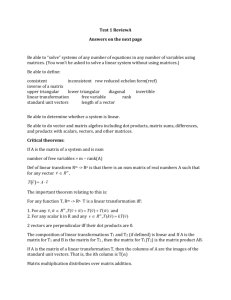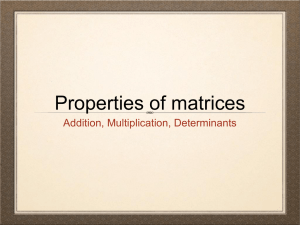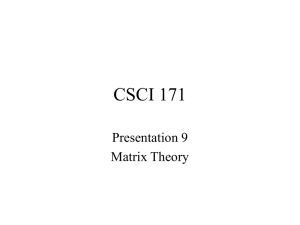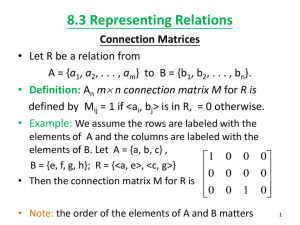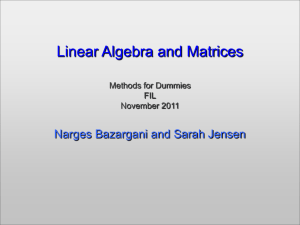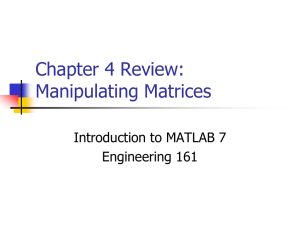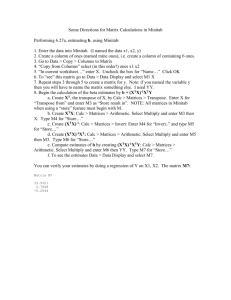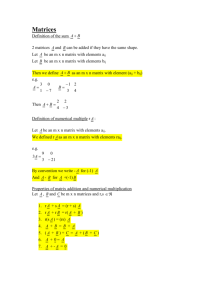Manic Matrices and Loony Lexicons
advertisement
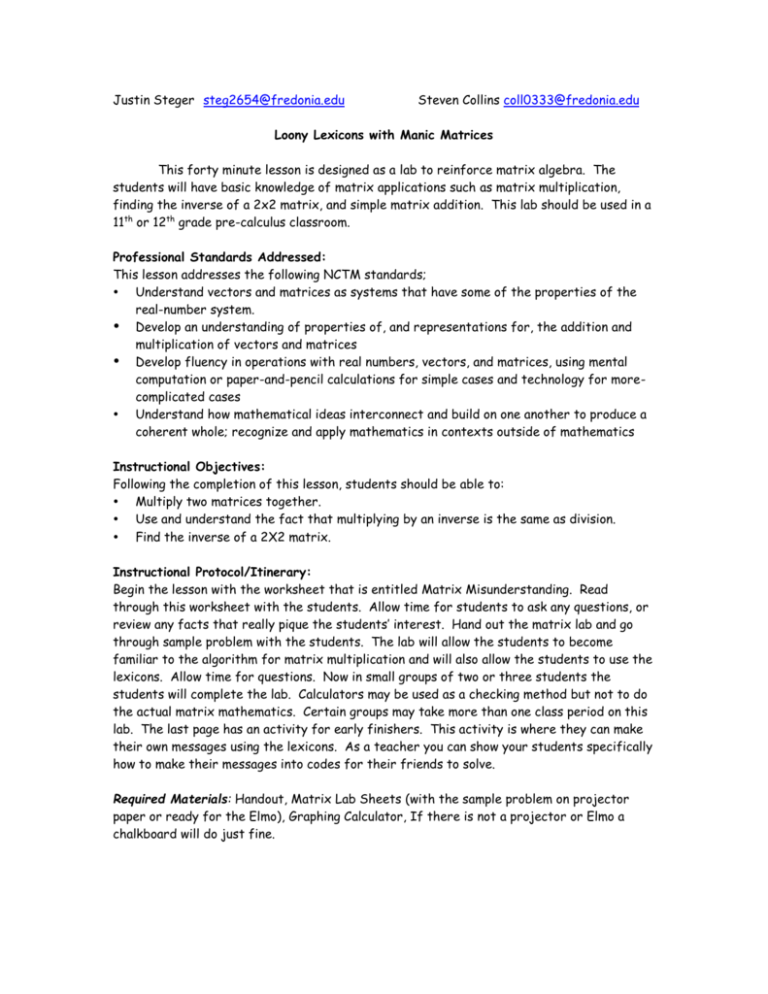
Justin Steger steg2654@fredonia.edu Steven Collins coll0333@fredonia.edu Loony Lexicons with Manic Matrices This forty minute lesson is designed as a lab to reinforce matrix algebra. The students will have basic knowledge of matrix applications such as matrix multiplication, finding the inverse of a 2x2 matrix, and simple matrix addition. This lab should be used in a 11th or 12th grade pre-calculus classroom. Professional Standards Addressed: This lesson addresses the following NCTM standards; Understand vectors and matrices as systems that have some of the properties of the real-number system. Develop an understanding of properties of, and representations for, the addition and multiplication of vectors and matrices Develop fluency in operations with real numbers, vectors, and matrices, using mental computation or paper-and-pencil calculations for simple cases and technology for morecomplicated cases Understand how mathematical ideas interconnect and build on one another to produce a coherent whole; recognize and apply mathematics in contexts outside of mathematics Instructional Objectives: Following the completion of this lesson, students should be able to: Multiply two matrices together. Use and understand the fact that multiplying by an inverse is the same as division. Find the inverse of a 2X2 matrix. Instructional Protocol/Itinerary: Begin the lesson with the worksheet that is entitled Matrix Misunderstanding. Read through this worksheet with the students. Allow time for students to ask any questions, or review any facts that really pique the students’ interest. Hand out the matrix lab and go through sample problem with the students. The lab will allow the students to become familiar to the algorithm for matrix multiplication and will also allow the students to use the lexicons. Allow time for questions. Now in small groups of two or three students the students will complete the lab. Calculators may be used as a checking method but not to do the actual matrix mathematics. Certain groups may take more than one class period on this lab. The last page has an activity for early finishers. This activity is where they can make their own messages using the lexicons. As a teacher you can show your students specifically how to make their messages into codes for their friends to solve. Required Materials: Handout, Matrix Lab Sheets (with the sample problem on projector paper or ready for the Elmo), Graphing Calculator, If there is not a projector or Elmo a chalkboard will do just fine. Name: Matrix Misunderstandings: As crazy as we math teachers are, there still are reasons for everything we teach you. Matrices are a unique way to solve equations and they have unique applications both in mathematics and the real-world. The study of matrices is quite old. A 3-by-3 magic square appears in the Chinese literature dating from as early as 650 BC. There are also matrices in Chinese texts from 300BC. Matrices were also found in Arab mathematics as early as the seventh century. In these texts matrices were used to simultaneously solve several equations. So you can see that this method is quite old. Matrices are used in encryption. You will see how later in this class. A famous encryption is the Hill Cipher, created in 1929. This cipher is not a great way to hide information but you can combine matrix encryption with other mathematical encryptions to make a message that is harder to decode. Computer graphics are made up of 4x4 matrices rotated in special ways. Matrices are used in chemistry to help balance equations. This will be discussed more in some chemistry classes you may take. Matrices are used in the visualization of permutations, or the layout of a sequence of tones or notes. This is written using the twelve tone technique. Matrices are used in engineering to find out the deformation of materials and heat conduction. This is especially useful in the creation of airplanes. Which came first the chicken or the… oops, sorry. Which came first the matrix or the determinant? Common sense say the matrix, but that would be wrong. The determinant was actually discovered before matrices. Matrices are sued to plot out complicated dance steps. Any dance that involves moving about a square is using an n by n matrix. In statistics, when considering a regression line matrices are used to help find the least squares, because it involves solving two linear equations with two unknowns. References: Dr. Robert Rogers Dr. Keary Howard Applied Linear Statistical Models by John Neter, William Wasserman, and Michael H. Kutner, pp. 238-240 http://www.shodor.org/unchem/math/matrix/index.html http://www.sciencenews.org/sn_arc97/6_14_97/mathland.htm Name: Matrix Lab Student Copy Direction for matrices lab: Did you know that matrices can be used to deliver coded messages? It’s true. In today’s lab, we are going to work on decoding some secret messages. Before you’re turned loose, let’s go over a message together. Let’s make it a standard rule of thumb that unless specifically told otherwise, you cannot use your calculator to solve matrices on this lab. You may check your answer at the end of the problem, and you may use your calculator for multiplication of numbers, but let’s work on improving our matrix algebra skills! Recall: If we are given a matrix AB and matrix A, how do you solve for matrix B? Example: The secret message to be decoded is in Matrix B. Matrix A: Matrix AB: 1 2 4 3 13 7 2 8 So now what do we do? Well, we know that we need to solve for Matrix B. This means we have to find A-1. Why? Recall that in matrix algebra, there is no division. So instead, we must multiply by the inverse. Step 1: Find A-1. Student’s Copy Step 2: Multiple the left-hand side of matrix AB by A-1. A-1(AB) = B. Step 3: Decode Matrix B. ..but how? Matrix B is just a bunch of numbers? What does it mean? Well, you can make the code however you feel like making it. For today’s lab, we’re going to be using the following lexicon. A lexicon acts like a dictionary, or key between two symbols. Space = 0 A=1 B = -1 C=2 D=2 … Write out the entire lexicon, following the pattern, then decode Matrix B. Student Copy: Now break yourself into groups of 2 or 3 and decode the following matrices. Note that from numbers 4 and 5, you have a different lexicon to use. See attached sheet for that lexicon. Problem 1: Hint: A common winter saying. Matrix A: Matrix AB: 9 7 5 4 20 33 37 86 124 91 39 12 19 20 48 69 52 20 Problem 2: Hint: Before the real world, there is… Matrix A: Matrix AB: 3 2 6 5 56 15 19 3 24 27 0 125 33 37 15 48 54 0 Problem 3: (Note: for this problem, just multiply the matrices together to get our coded matrix) Hint: A song you might sing in December. Matrix A: Matrix B: 1 2 5 2 3 2 10 23 39 0 15 25 13 4 11 32 20 28 1 1 2 2 1 3 2 2 1 1 2 2 For Problem 4 and 5, use new lexicon, on attached page. Note that we are now using an image lexicon. Problem 4: Hint: “If it makes you _____, it can’t be that bad.” ~Sheryl Crow Matrix A: Matrix AB: 1 8 1 7 17 25 15 22 Problem 5: (Note: for this problem, just multiple the matrices together to get the coded matrix) Hint: There’s no place like this. Matrix A: Matrix B: 63 67 48 52 28 30 2 3 1 3 0 1 3 6 2 1 0 3 1 1 2 2 Answer Key Example: If we are given a matrix AB and matrix A, how do you solve for matrix B? Answer: Multiple the left-hand side by the inverse for A, A-1. Step 1: Find A-1. A-1: Matrix A: d b 1 * db ac c a a b c d A-1: 3 2 5 5 4 1 5 5 Step 2: Multiple the left-hand side of matrix AB by A-1. A-1(AB) = B. 3 2 5 5 13 7 4 1 5 5 2 8 = B: 1 7 10 4 1 7 10 4 7 1 -10 4 MATH Problem 1: Matrix A: Matrix AB: 9 7 5 4 20 33 37 86 124 91 39 12 19 20 48 69 52 20 A-1: B: 4 7 5 9 4 1 8 8 13 0 4 8 6 5 2 1 13 10 -4 1 -8 -8 13 0 -4 8 -6 5 2 1 13 10 HAPPY HOLIDAYS Problem 2: Matrix A: Matrix AB: 3 2 6 5 56 15 19 3 24 27 0 125 33 37 15 48 54 0 A-1: B: 2 5 3 3 2 1 10 3 7 5 8 9 0 13 3 1 9 0 10 3 -7 5 8 -9 0 13 3 1 -9 0 SENIOR YEAR Problem 3: Matrix A: Matrix B: 1 2 5 2 3 2 10 23 39 0 15 25 13 4 11 32 20 28 1 1 2 2 1 3 2 2 1 1 2 2 AB: 6 3 10 0 5 10 0 10 7 8 12 0 -6 3 -10 0 5 -10 0 10 -7 8 12 0 LET IT SNOW Problem 4: Matrix A: Matrix AB: 1 8 1 7 17 25 15 22 A-1: B: 7 2 3 1 1 1 2 3 B: Problem 5: Matrix A: Matrix B: 63 67 48 52 28 30 2 3 1 3 0 Matrix AB: AB: 8 9 5 5 10 11 1 3 6 2 1 0 3 1 1 2 2


